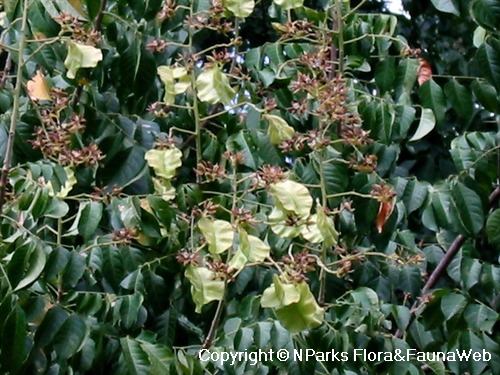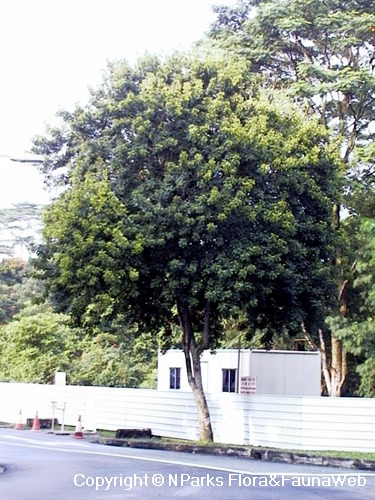_lowres.jpg)
Name
Classifications and Characteristics
| Plant Division | Angiosperms (Flowering Seed Plants) |
|---|---|
| Plant Growth Form | Tree |
| Mode of Nutrition | Autotrophic |
Biogeography
| Native Distribution | Thailand, Laos |
|---|---|
| Native Habitat | Terrestrial |
| Preferred Climate Zone | Tropical |
| Local Conservation Status | Non-native (Horticultural / Cultivated Only) |
Description and Ethnobotany
| Growth Form | Tree with round, bushy crown. |
|---|---|
| Foliage | Compound leaves are composed of 3-4 pairs of elliptical, but slightly asymmetric leaflets. Leaflets within a pair are slightly offset from each other and usually have smooth edges (sometimes toothed). Leaves are spirally arranged around the branches. |
| Flowers | Flowers have small, white petals and larger, red sepals (outermost layer of the flower). Flowers are arranged in branched inflorescences. |
| Fruit | Three-winged fruits are yellowish, papery and contain about 2 egg-shaped black seeds. |
| Cultivation | This tree is often planted in residential areas throughout Singapore. |
| Ethnobotanical Uses | Food (Herb or Spice) |
Plant Care and Propagation
| Light Preference | Full Sun |
|---|---|
| Water Preference | Moderate Water |
| Plant Growth Rate | Moderate |
Foliar
| Mature Foliage Colour(s) | Green |
|---|---|
| Leaf Area Index (LAI) for Green Plot Ratio | 3.0 (Tree - Intermediate Canopy) |
Floral (Angiosperm)
| Flower & Plant Sexuality | Bisexual Flowers |
| Flower Colour(s) | White, Red |
|---|---|
| Flower Grouping | Cluster / Inflorescence |
| Flower Location | Terminal |
Fruit, Seed and Spore
| Mature Fruit Colour(s) | Yellow / Golden |
|---|---|
| Mature Fruit Texture(s) | Papery |
| Fruit Classification | Simple Fruit |
| Fruit Type | |
| Mature Seed Colour(s) | Black |
| Mature Seed Texture(s) | Smooth |
| Seed Quantity Per Fruit | Few (1-5) |
Image Repository
Others
| Master ID | 1436 |
|---|---|
| Species ID | 2729 |
| Flora Disclaimer | The information in this website has been compiled from reliable sources, such as reference works on medicinal plants. It is not a substitute for medical advice or treatment and NParks does not purport to provide any medical advice. Readers should always consult his/her physician before using or consuming a plant for medicinal purposes. |

_lowres.jpg)
_lowres.jpg)
_lowres.jpg)

